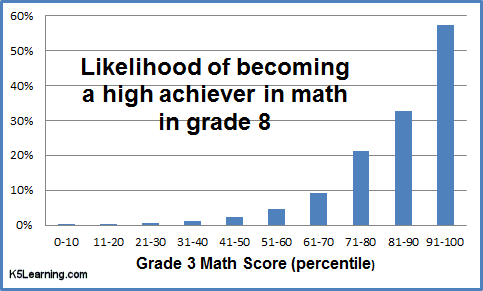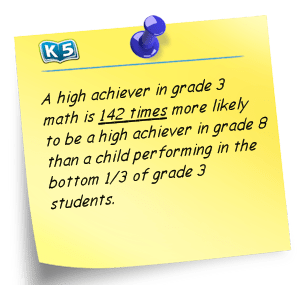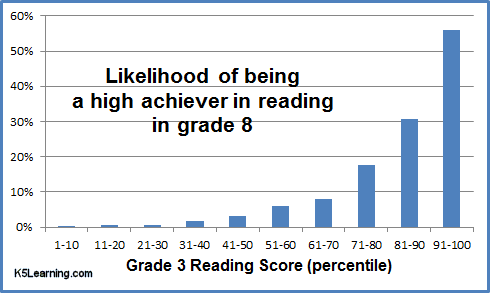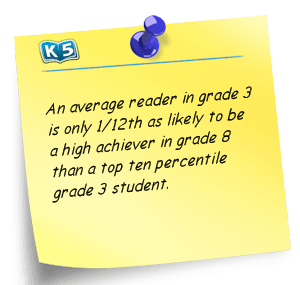Students below 70 percentile in grade 3 reading and math will rarely catch up

New data tells us that students who are not performing well above average in reading and math by grade 3 are highly unlikely to ever become academic high achievers.
Last month the Fordham Institute released Do High Flyers Maintain their Altitude?, an examination of the performance of high achieving students (those scoring in the top 10 percentile on widely written standardized tests). K5 Learning has reviewed the Fordham data to analyze those students who were not high achievers when first tested in grade 3. The results are a wake-up call for every parent of young children.
Grade 3, and the academic ship has sailed
In this massive study of tens of thousands students, children who performed in the bottom 1/3 in reading or math in grade 3 had less than a 1% chance of being high achievers by grade 8. Even average students in grade 3, (between 40 and 60 percentile) had less than a 5% chance of becoming high achievers later.

A high achiever in grade 3 math was 17 times more likely to be a high achiever in grade 8 than your average grade 3 student, and 142 times more likely than someone who was performing in the bottom third of students in grade 3. The results were broadly similar for reading.
Kids performing in the 60-70 percentile range in grade 3 had about a 8-9% chance of becoming high achievers by grade 8, still 6-7 times less likely than the stars in grade 3.
Kids performing in the 70s and 80s percentiles in grade 3 became high achievers in grade 8 only about 1/3 to 1/2 as often as the kids who were already in the top 10 percentile in grade 3.
The study found broadly similar correlations between grade 6 and grade 10 achievement levels.
Goodbye honor roll, goodbye Harvard
One can truly say that by grade 3, the academic ship has sailed, and if Johnny wasn’t on board then the chances of him becoming a top student are pretty slim.
It is generally accepted that the top high school students go to the best universities and dominate the best jobs. A 2009 McKinsey study found that a top quartile student in grade 8 is almost 6 times as likely to get a bachelor’s degree, and that success in school is highly correlated with lifetime earnings, with 70% of top earners having at least a bachelor’s degree.
The effects of globalization and the ever rising admission standards of leading universities will only serve to magnify this effect.
What is remarkable is the degree to which the top students are already defined by grade 3.
Why they don’t catch up
Preschool language ability has been estimated [Storch & Whitehurst, 2002] to account for 90% of individual differences in children’s language ability in kindergarten, with differences in kindergarten accounting for 96% of the differences in grades 1-2, and differences in grades 1-2 accounting for 88% of the differences in grades 3-4. This trend appears to continue in the later grades.

Reading and numeracy are fundamental to more advanced learning. A child who is a strong reader and good in math in grade 3 has the skillset to learn effectively; other kids can’t catch up because they are struggling with the basics while their peers are moving ever ahead.
We see learning as a continuum, and believe that those high achievers walking through the gates of top universities start with early learning, get challenged in the primary grades (enrichment classes, after-school learning, etc.), and keep excelling throughout their young lives.
A wake up call for parents
Despite the ample evidence of the importance of early learning, many parents are not proactive enough during the preschool years, and pursue little supplemental learning after kindergarten begins. Extra studying after school? We have heard it a thousand times: Let kids be kids, they’ll catch up later.

They won’t.
The sample size of this study, with 93,182 elementary reading students and 81,767 elementary math students, is so large, and the correlations so strong, that arguments over demographic issues, problems with standardized testing and so on can be set aside, leaving a clear message to parents: If you want your children to have a decent chance of going to a good university, then you need to make sure they develop the best reading and math skills they can by the time they are 8 years old. From books to tutors to online learning, the tools are out there, but it is up to parents to make education a priority in their children's lives from the earliest days.
We'd like to thank the Fordham Institute for providing us access to data from their report.

